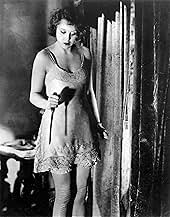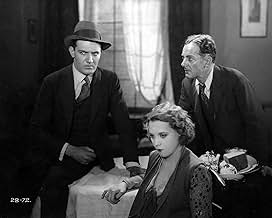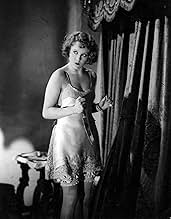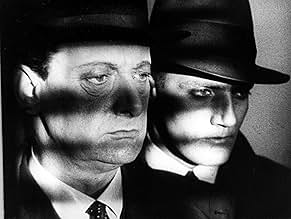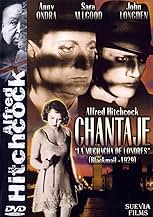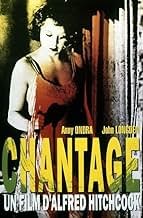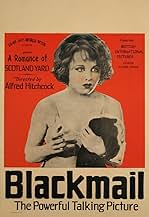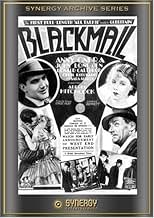CALIFICACIÓN DE IMDb
6.9/10
13 k
TU CALIFICACIÓN
Una mujer mata a un hombre en defensa propia, dando oportunidad al único testigo a que la chantajee.Una mujer mata a un hombre en defensa propia, dando oportunidad al único testigo a que la chantajee.Una mujer mata a un hombre en defensa propia, dando oportunidad al único testigo a que la chantajee.
- Dirección
- Guionistas
- Elenco
- Premios
- 2 premios ganados en total
Ex-Det. Sergt. Bishop
- The Detective Sergeant
- (as Ex-Det. Sergt. Bishop - Late C.I.D. Scotland Yard)
Johnny Ashby
- Boy
- (sin créditos)
Joan Barry
- Alice White
- (voz)
- (sin créditos)
Johnny Butt
- Sergeant
- (sin créditos)
Alfred Hitchcock
- Man on Subway
- (sin créditos)
Phyllis Konstam
- Gossiping Neighbour
- (sin créditos)
Sam Livesey
- The Chief Inspector (silent version)
- (sin créditos)
Phyllis Monkman
- Gossip Woman
- (sin créditos)
Percy Parsons
- Crook
- (sin créditos)
Opiniones destacadas
I have seen most of Alfred Hitchcock's films, silent and talking, and was saving this one for a special occasion. It was really quite good and although over-rated despite being cited so often (along with Mamoulian's "Applause") as a successful example of the transition between the silents and talkies in all the references I've consulted, it still has some distinct good qualities of its own. Annie Ondra is an excellent silent actress and this among several other films proves it. Her accent was very strong, of course, and employing Joan Barry to "lip-synch" was genial. Francois Truffaut's interviews with Hitchcock about working with Ms Ondra were enough to stimulate anyone's appetite to see her (and to hear Joan Barry) at work. The music - at least in the beginning - is excessively burdensome and "busy" and frankly irritating. However, when the characters finally began dialogue, it calmed down considerably and actually worked out well until the ending. We're seeing a hybrid here: a talkie and a part-talkie. When the talking itself finally happens, the characters aren't even facing the camera but are photographed from behind! This is the famous Hitchcock we know and love in the heat of action. The view of the staircase is very Hitchockian as in "Vertigo" or "Psycho" as well as the chase in a public monument (North by Northwest" comes to mind). Yes, the director made the move to talking pictures quite fluently and fluidly. One should keep in mind, too, that the film had already been completed as a silent before being converted into a talkie! All the more to admire...
Curtis Stotlar
Curtis Stotlar
A nice thriller with typical Hitch themes that remains famous thanks to a messy , complex story of attempted rape , killing in self-defense , blackmail , pursuit to death and look for Alfred's screen cameo . It is set in London , later a bitter discussion among lovers , the beautiful vendor Alice White (Amy Ondra , voice by Joan Barry) , sneaks away from her boyfriend and good-looking, efficient and impersonal Scotland Yard police , Frank Webber (John Longden) , to go out on an ill-advised date with the sleazy artist , Mr Crewe (Cyril Ritchard) . However, as the naive girl is lured into Crewe's studio, his sinister sexual advances will soon arm Alice's hand with a serrated bread knife, and before she knows it, the man lies dead in a pool of blood. As the saleswoman Alice getaways the scene of the crime in a numb haze , while the news of the unknown killer is spreading like wildfire all the way up to fiancé Frank's ears . Then Frank elides into a messy , personal story full of turns and while he attempts to keep his girlfriend from being involved .
An early talkie with script by Charles Bennett and Hitchcock himself , as usual , including a lot of sequences that remain genuinely amazing and striking . The dark atmosphere reeks with the feeling something nasty is going to happen any second . Britain's first period directed by Hitchcock who makes his ordinary small appearance on a tube train . It follows the police investigation of a murder with several twists and turns , while an invisible eyewitness will become a ruthless blackmailer . One of the first and best Alfred film to explore the ideas and themes that would become his trademarks , including climatic and memorable scenes . Future successful filmmakers Michael Powell and Ronald Neame were stills cameraman and clapper boy respectively .
The motion picture was well realized by Alfred Hitchcock , his first sound film for Great Britain . Being made as a silent movie , this was an early talkie , and still stunningly hypnotic to see today . In fact , being , nowadays ,more stimulating for its innovations in that area , and by experimenting with a peculiar narrative structure . This fine early effort by Hitch has several novelties , as the movie transcends the limitation of its mystery plot by dealing with thought-provoking issues and focusing on the theatrical meditations of reality . Here Alfred gives signs to be an expertise at tightening tension was already building up . The film belongs to Hitch's first British period when he directed silent films such as ¨The lodger¨ (1926) , ¨The ring¨(1927) , ¨Easy virtue¨ (1927) , ¨The Manxman¨(29) ; being ¨Blackmail¨(29) made as a silent , this was reworked to become a talkie . Following sound movies and early talkies as ¨Murder¨(1930 , ¨June and the Paycock¨(30) , ¨Skin Game¨(31) , ¨Rich and strange¨(32) , ¨Number 17¨(32) , ¨The man who knew too much¨(34) , ¨The 39 steps¨ (35) , ¨The secret agent¨(36) , ¨Sabotage¨(36) , ¨The lady vanishes¨(38) , ¨Jamaica Inn¨ (39) until he is hired by David O'Selznick to shoot¨Rebecca¨(40) in the US .
An early talkie with script by Charles Bennett and Hitchcock himself , as usual , including a lot of sequences that remain genuinely amazing and striking . The dark atmosphere reeks with the feeling something nasty is going to happen any second . Britain's first period directed by Hitchcock who makes his ordinary small appearance on a tube train . It follows the police investigation of a murder with several twists and turns , while an invisible eyewitness will become a ruthless blackmailer . One of the first and best Alfred film to explore the ideas and themes that would become his trademarks , including climatic and memorable scenes . Future successful filmmakers Michael Powell and Ronald Neame were stills cameraman and clapper boy respectively .
The motion picture was well realized by Alfred Hitchcock , his first sound film for Great Britain . Being made as a silent movie , this was an early talkie , and still stunningly hypnotic to see today . In fact , being , nowadays ,more stimulating for its innovations in that area , and by experimenting with a peculiar narrative structure . This fine early effort by Hitch has several novelties , as the movie transcends the limitation of its mystery plot by dealing with thought-provoking issues and focusing on the theatrical meditations of reality . Here Alfred gives signs to be an expertise at tightening tension was already building up . The film belongs to Hitch's first British period when he directed silent films such as ¨The lodger¨ (1926) , ¨The ring¨(1927) , ¨Easy virtue¨ (1927) , ¨The Manxman¨(29) ; being ¨Blackmail¨(29) made as a silent , this was reworked to become a talkie . Following sound movies and early talkies as ¨Murder¨(1930 , ¨June and the Paycock¨(30) , ¨Skin Game¨(31) , ¨Rich and strange¨(32) , ¨Number 17¨(32) , ¨The man who knew too much¨(34) , ¨The 39 steps¨ (35) , ¨The secret agent¨(36) , ¨Sabotage¨(36) , ¨The lady vanishes¨(38) , ¨Jamaica Inn¨ (39) until he is hired by David O'Selznick to shoot¨Rebecca¨(40) in the US .
One of Hitchcock's early films, it was one of the first films to come out of England with sound during the end of the silent film era. An interesting film, we see several great shots of dolly's with the early staircase scene. Several well shot montages with wonderful dissolves and sound bridges. For 1929, Hitchcock shows the world with the film that he's a talented film maker. A risky scene, the audience gets to watch the main actress of the film undress behind her curtains. While the murder is never seen, the provocative and private scene of her undressing is present. Another interesting note, the main character of the film is the murderer! Throughout the film, the audience judges whether or not she is an innocent murderer or a killer. Hitchcock makes an early name for himself with this film with toying with the audience throughout the suspense of the film.
A common motif in Alfred Hitchcock's movies is the guilty woman: "Blackmail", "Psycho" and "The Birds" are all prime examples. In "Blackmail", Alice White (Anny Ondra) goes home with an artist one night and he tries to rape her. She murders him, and from then on everything reminds her of it. The jester painting appears to be looking at her (or she at it?), a billboard looks like a knife, and a woman keeps uttering the word knife. But in the end, everything blows up in Alice's face.
Hitch was certainly showing his chops here. The camera angles, scenery, and other such things all combined to make what we would expect in a Hitchcock movie. I try to imagine being a moviegoer in 1929 watching "Blackmail" for the first time, wondering what Hitchcock's subsequent work would be like.
Hitch was certainly showing his chops here. The camera angles, scenery, and other such things all combined to make what we would expect in a Hitchcock movie. I try to imagine being a moviegoer in 1929 watching "Blackmail" for the first time, wondering what Hitchcock's subsequent work would be like.
Hitchcock's Blackmail might have been a total train wreck in the hands of a lesser talent. Instead, it is a remarkable piece of cinematic history, and still tremendously entertaining after 78 years. The film was partly shot when Hitchcock learned that he would have access to sound equipment. His female lead was a talented German silent picture actress, whose accent was too heavy for sound, so an off-camera reader had to be used, plus a decent amount of expensive film had already been used and had to be integrated into the 'talkie' as well.
All considered, the movie is probably the best example of the transition from these two cinematic paradigms that can be found.
The silent portion of the film establishes John Longden's character as a hard-nosed young Scotland Yard detective. Anny Ondra plays the lovely young lady who is engaged to him,and who soon becomes the center of our attention. One night after they argue over some petty matters, they part company and Anny meets up with a male artist friend, who, unbeknownst to her, is interested in more than just pleasant conversation. Frank (Longden) spots them leaving the restaurant and follows them for a while. The artist coaxes Alice (Ondra) up to his flat, and things take a sinister turn in short order.
Over the second half of the film, the plots unfolds, and the emotions and consciences of the protagonists are sorely tried.
What immediately blew my mind was what a great silent director Hitchcock was. Shouldn't have been too surprising since Hitchcock has always struck me as a master cinematographer. The first 20 minutes of the film are completely silent,and there are no interruptions from distracting story boards. Nevertheless, through incredible use of lighting, camera work, and evocative acting, you understand everything that is going on clearly, and are drawn straight into the edgy atmosphere so familiar to those who appreciate the work of this great director.
The acting is mostly very good. Only Longden sometimes seems to over or under-act his part, and Ondra is really wonderful all the way through. I was not surprised to learn of her lengthy and productive career both before and after this film and will now look for more of her work.It is also interesting to see how the actors adapted so readily to the new medium. Although some have said that the sound portion of this film seemed over-acted because the actors were still clinging to silent film conventions, I really can not agree. Some of the characters (Alice, for example) required very evocative, rather physical performances, and I can't imagine how she could have done better.
Highly recommended for the amazing photography, exceptionally professional though very early use of sound, and the typically perfect pace.
All considered, the movie is probably the best example of the transition from these two cinematic paradigms that can be found.
The silent portion of the film establishes John Longden's character as a hard-nosed young Scotland Yard detective. Anny Ondra plays the lovely young lady who is engaged to him,and who soon becomes the center of our attention. One night after they argue over some petty matters, they part company and Anny meets up with a male artist friend, who, unbeknownst to her, is interested in more than just pleasant conversation. Frank (Longden) spots them leaving the restaurant and follows them for a while. The artist coaxes Alice (Ondra) up to his flat, and things take a sinister turn in short order.
Over the second half of the film, the plots unfolds, and the emotions and consciences of the protagonists are sorely tried.
What immediately blew my mind was what a great silent director Hitchcock was. Shouldn't have been too surprising since Hitchcock has always struck me as a master cinematographer. The first 20 minutes of the film are completely silent,and there are no interruptions from distracting story boards. Nevertheless, through incredible use of lighting, camera work, and evocative acting, you understand everything that is going on clearly, and are drawn straight into the edgy atmosphere so familiar to those who appreciate the work of this great director.
The acting is mostly very good. Only Longden sometimes seems to over or under-act his part, and Ondra is really wonderful all the way through. I was not surprised to learn of her lengthy and productive career both before and after this film and will now look for more of her work.It is also interesting to see how the actors adapted so readily to the new medium. Although some have said that the sound portion of this film seemed over-acted because the actors were still clinging to silent film conventions, I really can not agree. Some of the characters (Alice, for example) required very evocative, rather physical performances, and I can't imagine how she could have done better.
Highly recommended for the amazing photography, exceptionally professional though very early use of sound, and the typically perfect pace.
¿Sabías que…?
- TriviaMuch of the filming originally was shot silently. When sound became available during the course of shooting, Sir Alfred Hitchcock reshot certain scenes with sound, thus making it his first talkie. There was one complication with this change, however. Leading lady Anny Ondra had a thick Czech accent which was inappropriate for her character, Alice White. Joan Barry was chosen to provide a different voice for her, but post-production dubbing technology did not exist then. The solution was for Barry to stand just out of shot and read Alice's lines into a microphone as Ondra mouthed them in front of the camera. [This is a major plot point of Cantando bajo la lluvia (1952), which is set in the era of movie studios moving from silent pictures to talkies.] This generally is acknowledged as the first instance of one actress' voice being dubbed by another, even though the word "dub" is technologically inappropriate in this case.
- ErroresAt about 0:24:30 when Crewe (Cyril Ritchard) is talking to Alice (Anny Ondra), he calls her "Anny" before correcting himself.
- Citas
Alice White: You and your Scotland Yard! If it weren't for Edgar Wallace, no one would ever have heard of it.
- Versiones alternativasOriginally filmed as a silent movie, running 75 minutes; Hitchcock later added newly shot scenes and had other existing footage dubbed to create a talkie version, running 86 minutes.
- ConexionesEdited into Der Zinker (1931)
- Bandas sonorasMiss Up-to-Date
(1929) (uncredited)
Words by Frank Eyton and music by Billy Mayerl
Performed by Cyril Ritchard
Selecciones populares
Inicia sesión para calificar y agrega a la lista de videos para obtener recomendaciones personalizadas
Detalles
Taquilla
- Total a nivel mundial
- USD 160
- Tiempo de ejecución1 hora 25 minutos
- Color
- Relación de aspecto
- 1.20 : 1
Contribuir a esta página
Sugiere una edición o agrega el contenido que falta

Principales brechas de datos
By what name was Blackmail (1929) officially released in India in English?
Responda
